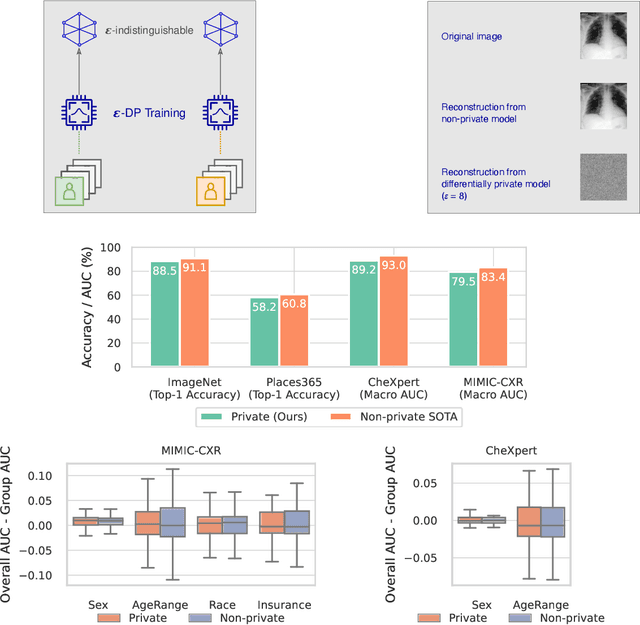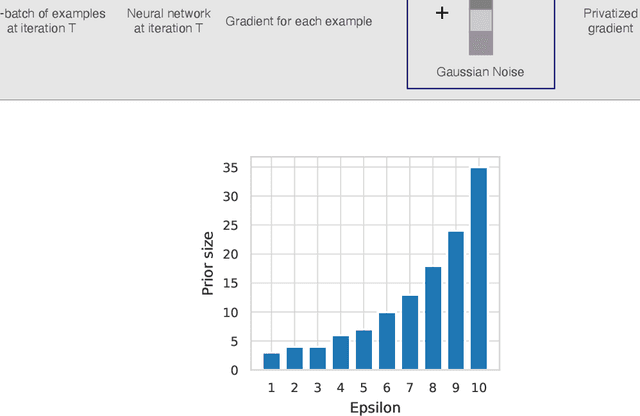Judy Hanwen Shen
Societal Impacts Research Requires Benchmarks for Creative Composition Tasks
Apr 09, 2025Abstract:Foundation models that are capable of automating cognitive tasks represent a pivotal technological shift, yet their societal implications remain unclear. These systems promise exciting advances, yet they also risk flooding our information ecosystem with formulaic, homogeneous, and potentially misleading synthetic content. Developing benchmarks grounded in real use cases where these risks are most significant is therefore critical. Through a thematic analysis using 2 million language model user prompts, we identify creative composition tasks as a prevalent usage category where users seek help with personal tasks that require everyday creativity. Our fine-grained analysis identifies mismatches between current benchmarks and usage patterns among these tasks. Crucially, we argue that the same use cases that currently lack thorough evaluations can lead to negative downstream impacts. This position paper argues that benchmarks focused on creative composition tasks is a necessary step towards understanding the societal harms of AI-generated content. We call for greater transparency in usage patterns to inform the development of new benchmarks that can effectively measure both the progress and the impacts of models with creative capabilities.
Two Tickets are Better than One: Fair and Accurate Hiring Under Strategic LLM Manipulations
Feb 18, 2025Abstract:In an era of increasingly capable foundation models, job seekers are turning to generative AI tools to enhance their application materials. However, unequal access to and knowledge about generative AI tools can harm both employers and candidates by reducing the accuracy of hiring decisions and giving some candidates an unfair advantage. To address these challenges, we introduce a new variant of the strategic classification framework tailored to manipulations performed using large language models, accommodating varying levels of manipulations and stochastic outcomes. We propose a ``two-ticket'' scheme, where the hiring algorithm applies an additional manipulation to each submitted resume and considers this manipulated version together with the original submitted resume. We establish theoretical guarantees for this scheme, showing improvements for both the fairness and accuracy of hiring decisions when the true positive rate is maximized subject to a no false positives constraint. We further generalize this approach to an $n$-ticket scheme and prove that hiring outcomes converge to a fixed, group-independent decision, eliminating disparities arising from differential LLM access. Finally, we empirically validate our framework and the performance of our two-ticket scheme on real resumes using an open-source resume screening tool.
Towards Data-Centric RLHF: Simple Metrics for Preference Dataset Comparison
Sep 15, 2024Abstract:The goal of aligning language models to human preferences requires data that reveal these preferences. Ideally, time and money can be spent carefully collecting and tailoring bespoke preference data to each downstream application. However, in practice, a select few publicly available preference datasets are often used to train reward models for reinforcement learning from human feedback (RLHF). While new preference datasets are being introduced with increasing frequency, there are currently no existing efforts to measure and compare these datasets. In this paper, we systematically study preference datasets through three perspectives: scale, label noise, and information content. We propose specific metrics for each of these perspectives and uncover different axes of comparison for a better understanding of preference datasets. Our work is a first step towards a data-centric approach to alignment by providing perspectives that aid in training efficiency and iterative data collection for RLHF.
The Data Addition Dilemma
Aug 08, 2024Abstract:In many machine learning for healthcare tasks, standard datasets are constructed by amassing data across many, often fundamentally dissimilar, sources. But when does adding more data help, and when does it hinder progress on desired model outcomes in real-world settings? We identify this situation as the \textit{Data Addition Dilemma}, demonstrating that adding training data in this multi-source scaling context can at times result in reduced overall accuracy, uncertain fairness outcomes, and reduced worst-subgroup performance. We find that this possibly arises from an empirically observed trade-off between model performance improvements due to data scaling and model deterioration from distribution shift. We thus establish baseline strategies for navigating this dilemma, introducing distribution shift heuristics to guide decision-making on which data sources to add in data scaling, in order to yield the expected model performance improvements. We conclude with a discussion of the required considerations for data collection and suggestions for studying data composition and scale in the age of increasingly larger models.
Multigroup Robustness
May 01, 2024Abstract:To address the shortcomings of real-world datasets, robust learning algorithms have been designed to overcome arbitrary and indiscriminate data corruption. However, practical processes of gathering data may lead to patterns of data corruption that are localized to specific partitions of the training dataset. Motivated by critical applications where the learned model is deployed to make predictions about people from a rich collection of overlapping subpopulations, we initiate the study of multigroup robust algorithms whose robustness guarantees for each subpopulation only degrade with the amount of data corruption inside that subpopulation. When the data corruption is not distributed uniformly over subpopulations, our algorithms provide more meaningful robustness guarantees than standard guarantees that are oblivious to how the data corruption and the affected subpopulations are related. Our techniques establish a new connection between multigroup fairness and robustness.
Unifying Corroborative and Contributive Attributions in Large Language Models
Nov 20, 2023Abstract:As businesses, products, and services spring up around large language models, the trustworthiness of these models hinges on the verifiability of their outputs. However, methods for explaining language model outputs largely fall across two distinct fields of study which both use the term "attribution" to refer to entirely separate techniques: citation generation and training data attribution. In many modern applications, such as legal document generation and medical question answering, both types of attributions are important. In this work, we argue for and present a unified framework of large language model attributions. We show how existing methods of different types of attribution fall under the unified framework. We also use the framework to discuss real-world use cases where one or both types of attributions are required. We believe that this unified framework will guide the use case driven development of systems that leverage both types of attribution, as well as the standardization of their evaluation.
Unlocking Accuracy and Fairness in Differentially Private Image Classification
Aug 21, 2023



Abstract:Privacy-preserving machine learning aims to train models on private data without leaking sensitive information. Differential privacy (DP) is considered the gold standard framework for privacy-preserving training, as it provides formal privacy guarantees. However, compared to their non-private counterparts, models trained with DP often have significantly reduced accuracy. Private classifiers are also believed to exhibit larger performance disparities across subpopulations, raising fairness concerns. The poor performance of classifiers trained with DP has prevented the widespread adoption of privacy preserving machine learning in industry. Here we show that pre-trained foundation models fine-tuned with DP can achieve similar accuracy to non-private classifiers, even in the presence of significant distribution shifts between pre-training data and downstream tasks. We achieve private accuracies within a few percent of the non-private state of the art across four datasets, including two medical imaging benchmarks. Furthermore, our private medical classifiers do not exhibit larger performance disparities across demographic groups than non-private models. This milestone to make DP training a practical and reliable technology has the potential to widely enable machine learning practitioners to train safely on sensitive datasets while protecting individuals' privacy.
Dissenting Explanations: Leveraging Disagreement to Reduce Model Overreliance
Jul 14, 2023Abstract:While explainability is a desirable characteristic of increasingly complex black-box models, modern explanation methods have been shown to be inconsistent and contradictory. The semantics of explanations is not always fully understood - to what extent do explanations "explain" a decision and to what extent do they merely advocate for a decision? Can we help humans gain insights from explanations accompanying correct predictions and not over-rely on incorrect predictions advocated for by explanations? With this perspective in mind, we introduce the notion of dissenting explanations: conflicting predictions with accompanying explanations. We first explore the advantage of dissenting explanations in the setting of model multiplicity, where multiple models with similar performance may have different predictions. In such cases, providing dissenting explanations could be done by invoking the explanations of disagreeing models. Through a pilot study, we demonstrate that dissenting explanations reduce overreliance on model predictions, without reducing overall accuracy. Motivated by the utility of dissenting explanations we present both global and local methods for their generation.
Accuracy, Interpretability, and Differential Privacy via Explainable Boosting
Jun 17, 2021Abstract:We show that adding differential privacy to Explainable Boosting Machines (EBMs), a recent method for training interpretable ML models, yields state-of-the-art accuracy while protecting privacy. Our experiments on multiple classification and regression datasets show that DP-EBM models suffer surprisingly little accuracy loss even with strong differential privacy guarantees. In addition to high accuracy, two other benefits of applying DP to EBMs are: a) trained models provide exact global and local interpretability, which is often important in settings where differential privacy is needed; and b) the models can be edited after training without loss of privacy to correct errors which DP noise may have introduced.
Fast and Memory Efficient Differentially Private-SGD via JL Projections
Feb 05, 2021



Abstract:Differentially Private-SGD (DP-SGD) of Abadi et al. (2016) and its variations are the only known algorithms for private training of large scale neural networks. This algorithm requires computation of per-sample gradients norms which is extremely slow and memory intensive in practice. In this paper, we present a new framework to design differentially private optimizers called DP-SGD-JL and DP-Adam-JL. Our approach uses Johnson-Lindenstrauss (JL) projections to quickly approximate the per-sample gradient norms without exactly computing them, thus making the training time and memory requirements of our optimizers closer to that of their non-DP versions. Unlike previous attempts to make DP-SGD faster which work only on a subset of network architectures or use compiler techniques, we propose an algorithmic solution which works for any network in a black-box manner which is the main contribution of this paper. To illustrate this, on IMDb dataset, we train a Recurrent Neural Network (RNN) to achieve good privacy-vs-accuracy tradeoff, while being significantly faster than DP-SGD and with a similar memory footprint as non-private SGD. The privacy analysis of our algorithms is more involved than DP-SGD, we use the recently proposed f-DP framework of Dong et al. (2019) to prove privacy.
 Add to Chrome
Add to Chrome Add to Firefox
Add to Firefox Add to Edge
Add to Edge